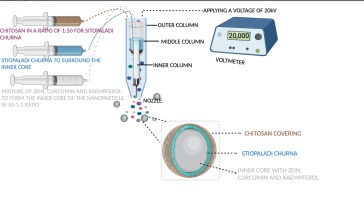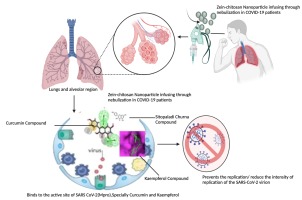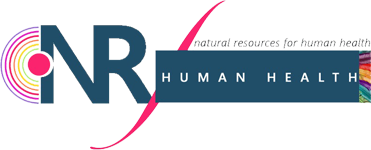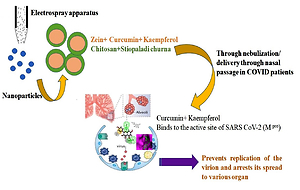BACKGROUND
The present serendipitous global pandemic Coronavirus disease (COVID-19) has knocked off the world with no way to treat it successfully or combat it efficiently. Hence, the peoples in the world anticipated developing a vaccine for striking the disease's frightfulness and fatality along with its effective cure. Some countries utilize chloroquine, few drugs used to treat autoimmune disorders and antiviral medication as a promising therapeutic approach (Savarino, Boelaert, Cassone, Majori, & Cauda, 2003). The limitation of proving its efficacy in the initial stage of the strict contagiousness monitoring to avoid arrhythmic death. Despite these medications, the death rate due to the exotic coronavirus is uncontrollable. Consequently, demand for the safer and effective curative measure for this pandemic is the need of the hour. Though the route for vaccination may be intranasal, present investigations use systemic routes to overcome many mucosal environment barriers like low intrinsic absorption, low dosage level, brisk mucociliary sweeping and enzymatic destruction striking the target site. Hence, the therapeutics approach via nanoparticles (NP) will reach the specific infected site, supply a higher concentration than the conventional therapeutic approach, and reduce the toxic effects on healthy cells.
Globally, COVID-19 cases have shown acute respiratory distress syndrome (ARDS) in intensive care units (Fan, Beitler, & Brochard, 2020), which is a sore type of acute lung injury (ALI) manifested by infection-causing inflammations and tissue fibrosis. ARDS can be induced by pre-depositing factors like pneumonia, sepsis and aspirations (Matthay & Zimmerman, 2005). Studies byAvasarala, Zhang, Liu, Wang, and London (2013) suggested that the potential role of Indian spice turmeric in modulating the chemokines and cytokines potentiality by reducing phosphorylated nuclear factor kappa B (NF-kB) p65 forms in mouse models for ARDS induced by the virus. Similarly,Praditya et al. (2019) in their review, highlighted the antiviral role of the golden spice curcumin against human pathogens like the influenza virus, Human Immunodeficiency Virus (HIV). Other studies by Ziteng and Ying (2020) highlighted that the use of curcumin as a potent mitigant for pro and anti-inflammatory components like interleukin (IL-6), cyclooxygenase (COX-2) by prompting inflammation through increasing the apoptosis rate in polymorphonuclear cells (PMNs), thereby, searching the reactive oxygen species (ROS). In another study,Rastogi, Pandey, and Singh (2020) suggested utilizing formulations like Sitopaladi churna (SPC) in COVID-19 positive cases with mild symptoms showed immediate blocking of the symptoms and control on contagion spread via continuous check-ups in isolation. Makhija, Shreedhara, and Ram (2013) proposed that the administration of SPC hinders mast cells mediators release, and these mast cells activate cytokine storm resulting in disruption of lungs and its complications, lethal inflammations and demise in COVID-19 [9]. Parallelly, kaempferol a beneficial flavonoid typically used for its anti-inflammatory properties in ALI studies and the molecular docking study by Khaerunnisa, Kurniawan, Awaluddin, Suhartati, and Soetjipto (2020), when compared with other medicinal plants and is suggested as a capable inhibitor of the amino acid residue Mpro (main protease) responsible for the viral replication in COVID-19 active site (Aziz, Kim, & Cho, 2018).
Based on the available evidence, we suggest that infusing polyherbal constituents in a biocompatible nanoparticle can act as a potent therapeutic agent for COVID-19. Hence, in this viewpoint, we address utilizing curcumin along with SPC and kaempferol in a biocompatible NP like zein-chitosan as an adjuvant therapy for combating the severe acute respiratory syndrome coronavirus 2 (SARS-CoV-2) virion with lesser or no side effects on the surrounding healthier cells including COVID-19 vaccinations.
Curcumin
The diphenolic [1,7-bis(4-hydroxy-3-methoxyphenyl)-1, 6-heptadiene-3,5-dione] is an important constituent of turmeric (Curcuma longa L.); curcumin is known for its antioxidative, anti-inflammatory, antipathogenic and anticancer characteristics (Baspinar, Üstündas, Bayraktar, & Sezgin, 2018) with a disadvantage of abysmal bio-accessibility and weak solubility to disrupt its therapeutic benefits (Shaikh, Ankola, Beniwal, Singh, & Kumar, 2009). Therefore, to improve its bio-therapeutic efficacy, the water solubility is ameliorated using particles in a smaller nanometer range via nanotechnology (Sultana, Khan, Kumar, Kumar, & Ali, 2013). Encapsulating curcumin to aggrandize its weaker solubility and securing against atrophy by fusing it with a natural amplifier like piperine to enhance its absorptive property (Han, Tan, & Lim, 2008) along with chitosan to increase bioavailability of curcumin. Past decades, coronavirus is the centre of attraction due to its high virulence rate by its high cytokine storms aiding lethal pneumonia and preliminarily manifesting ALI/ARDS with a higher death rate (Peiris, Guan, & Yuen, 2004). The prime cause of spiked up fatality is the lungs' hyperactive immune cells (Channappanavar & Perlman, 2017). Many consensus types of research showed promising results on utilizing curcumin during viral-induced pneumonia, surpassing lung condition and boosting the survival range (Avasarala et al., 2013; Lai et al., 2020). Recently, evidence shows that a minimal (80mg/day) dosage of curcumin promotes healing properties like direct and indirect antioxidant properties (Disilvestro, Joseph, & Zhao, 2012). According to Lai et al. (2020), administrating the curcumin before and even after lurgy enhances lungs functioning, suggesting curcumin’s prophylactic and medicinal effect in these viruses instigated death or pneumonia. A pilot study by Alizadeh et al. (2018) reduces oxidative stress and declines inflammatory cytokines like tumor necrosis factor-a (TNF-a). Due to genetic similarity between SARS-CoV-2 and SARS/Middle East respiratory syndrome coronavirus, curcumin can hinder virion replication (Soni, Mehta, & Ratre, 2020). According to molecular docking, homology modelling and free binding energy calculation studies curcumin was found effective against SARS-CoV-2 viral proteases (Palaniyandi et al., 2020). The curative and preventive effects of curcumin in viral infection and cytokine storm can be the best option for managing the present pandemic situation.
Sitopaladi churna
Sitopaladi Churna (SPC) connotes to the grounded form of a single or blends of many drugs. One of the consistently used formulate to relieve respiratory disturbance, and constituting Saccharum officinarum L. (sugar candy), Bambusa arundinacea (Retz.) Willd. (Vanshlochan), Piper longum L. (dried fruit), Elettaria cardamomum (L.) Maton (dried seed) and Cinnamomum zeylanicum Blume (stem bark) (Jani, Thaker, & Satakopan, 1980). P. longum's having important compound piperine, which has shown to decline the magnitude and rate of blockage caused by acetylcholine, histamine and 5-hydroxytryptamine (5-HT)-induced spasm on guinea pig and rabbit's intestine along with preventing bronchospasm. In the same way, the anti-inflammatory properties of B. arundinacea and E. cardamomum are shown in patients with asthma and cold-cough. Even C. zeylanicum aqueous solution has shown an anti-complement (Ahirwar, Ahirwar, & Ram, 2008); as this churna has shown to shield mast cells from degranulation significantly (Makhija et al., 2013) which is the primary site of the SARS-CoV-2 entry (Caughey, Raymond, & Wolters, 2000). We suggest the administration of SPC and curcuma via nanoparticle in COVID-19 cases spread in body by blocking mast cells and modulating the pathway of the virus in addition to spasms and congestion reduction.
Flavonoid-Kaempferol
Kaempferol-3, also known as kaempferide or kaempferol flavonol, is a naturally yellow powder flavonoid that is a flavonoid with hydrophobic property is found in vegetables, and fruits like kale, spinach, grapefruit etc., are known to have anti-inflammatory properties in vascular endothelial inflammations, chronic disorders like intervertebral disc degeneration (IVD), ALI along with benign and mignant cancers (Ren et al., 2019). Studies by Khaerunnisa et al. (2020) showed the molecular docking efficiency of kaempferol with the COVID-19 main protease (Mpro)/chymotrypsin-like protease (3CLpro) along with other flavonoids. According to Xu et al. (2020) kaempferol is one of the most potent inhibitors of COVID-19 Mpro and expresses its similarity with Nelfinavir, which is suggested as a potential macromolecular inhibitor for the current pandemic (COVID-19 Mpro).
Nanoencapsulation in Zein-chitosan complex
Nanoparticles are the centre of attention in biomedical research and pharmaceutical industries at present as they provide better compliance, wider distribution inside the biological system and most importantly, their site-specificity in conveying drugs. Besides, few nanoparticles are pocket and environment friendly (Vallet-Regí et al., 2016). Utilizing biopolymers as an essential constituent of nanoparticle's increases its biological affinity, biological breakdown and lesser pernicious. The bioactive compounds in biocompatible nanoparticles increase their intracellular permeability (Mora-Huertas, Fessi, & Elaissari, 2010). Generally, the therapeutic compounds are immobilized in a material either to coat or disperse to improve the therapeutics' drawbacks like lower solubility, safeguarding from moisture, pH and lights effects. Based on Cao, Luo, Tu, Wang, and Jiang (2014), the report suggested that the electrospray or electrohydrodynamic atomization method for building polymeric nanoparticle with a hydrophobic compound like curcumin and kaempferol. Naturally occurring polymer zein, a maize protein that consists of aqueous insoluble and alcohol soluble groups, can be used as a potent matrix for our selected compounds along with a secondary multi-group layer to increase the viscosity and promote bioavailability due to its high water solubility, more excellent permeability, and time-release with its promising properties and non-toxic, biocompatible and skilfully liable. As chitosan is initially positively charged, it can easily interact at the negatively charged cell surfaces sites, making it an ideal polymer to develop delivery nanoparticle (Gordon, Saupe, Mcburney, Rades, & Hook, 2008).
With this evidence, we suggest amalgaming the hydrophobic curcumin and kaempferol SPC in zein-chitosan tiny particles of approximate dimension of 500-600 nm can be used as a potent therapeutic agent for the current COVID-19 situation. Curcumin and kaempferide are trapped within zein as the core of the nanoparticles, and SPC with chitosan as the nanoparticle's shell electro-spraying method. Baspinar et al. (2018) ascertained that the curcumin and piperine infused zein nanoparticle with 550 nm, along with a ratio of 1:20 for curcumin: zein and 1:50 for piperine: chitosan at 20kV applied voltage is reliable to kill neuroblastoma cells (Figure 1). Hence, a similar protocol can infuse the cocktail compound in the biopolymers to get a biocompatible and effective nanoparticle to fight the current situation.
DISCUSSION
The current model of supplying drugs through nanoparticles is highly recommended over the classical drug administration method due to its higher efficacy, bioavailability, lesser toxicity, site-specificity, lower dosage, cross biological barriers (Kobayashi, Wei, Iida, Ijiro, & Niikura, 2014). A respiratory malaise, COVID-19 can be handled through the non-invasive mode of transporting the medicinal compounds at the infection site. The zein-chitosan nanoparticles complex with the phytocomponents can be delivered as a suspension in a gaseous medium in a respirable form through nebulizers for easy inhalation and higher deposition plus retention in the lungs (Aziz et al., 2018). The hypothesis's fundamental motive is to illustrate the idea (Figure 2) of using the plant-derived compound to overcome or track down the world's current scenario more safely and productively.
Figure 1
Biocompatible nanoparticle synthesis.
Preparing the zein-chitosan nanoparticle infused with the bioactive compound curcumin and kaempferol in the core (zein) of the nanoparticle and the SPC as the second layer along with chitosan as exterior layer due to higher stability and higher affinity towards cellular uptake.

Figure 2
The illustration depicts the postulate of utilizing biocompatible nanoparticle filled with active biological components as a curative and safer measure for the present pandemic COVID-19.
Administering the prepared nanoparticle complex via nasal track in COVID-19 patients to directly interact with the affected organ and prevent virion replication any further. Thereby reducing the spread and disease severity in the patient.

In summary, claiming more than 2 million human lives, SARS-CoV-2 globally talked about a health concern, keeping people on their toes. As of now, precaution is considered the best mode to handle the infection. The absence of a potent specific cure made the patients obtain treatments based on symptoms or supportive remedies. Globally, scientists are actively engaged in developing a safe and successful cure or vaccine. Nanotechnological techniques have shown promising health and disease-related problems in humans from the past few decades by incorporating antiviral compounds. Hence, utilizing this technology's idiosyncratic ability and organic compounds can comfort us during ongoing situations in addition to vaccination. Nevertheless, an in-depth investigation is required to assess the likeliness to utilize medicinal plant’s compounds against the current pandemic.
Conflicts of interest
The authors state that no commercial or financial links existed that may be interpreted as a potential conflict of interest.
Author contributions
This review article was carried out in collaboration between the authors. Conceptualization, B.B, and A.M; Writing—original draft preparation, H.K., B.B.., Selected bibliographic sources, M.P., V.A., M.S., M.E., R.B; K.P.,; B.B was coordinated the working group; Writing-review & editing, B.B., A.M.. All authors have reviewed and approved the published version.



